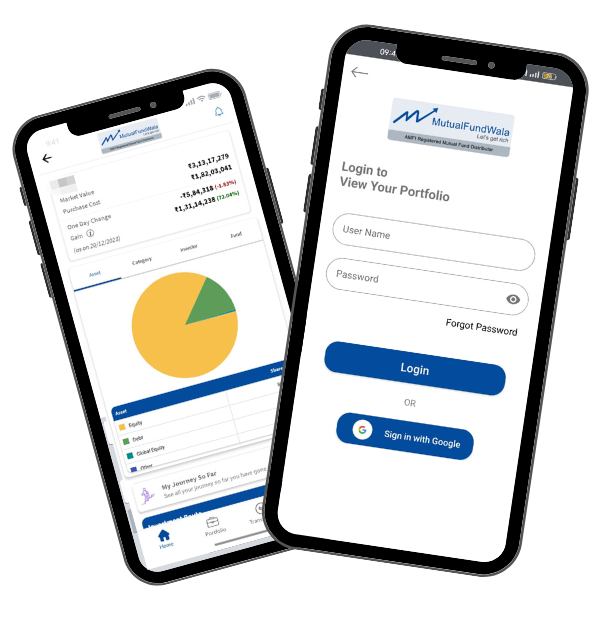Imagine a future where your money isn’t just sitting idle in a savings account but is actively working for you—growing, multiplying, and helping you achieve your dreams.
Whether it’s buying your first home, securing your child’s education, or ensuring a comfortable retirement, investing in mutual funds can be the key to unlocking your financial goals.
Mutual funds have captured the attention of Indian investors at an unprecedented rate in recent years, as assets under management (AUM) have grown from Rs 24 trillion in July 2019 to over Rs 64 trillion by July 2024, according to the Association of Mutual Funds in India (AMFI), boosted by a growing middle class, strong GDP expansion, and rising financial literacy.
But what makes mutual funds so appealing? Being a part of a professionally managed, diversified portfolio that aligns with your unique financial objectives is what makes mutual funds so appealing.
If the idea of investing seems overwhelming, you’re not alone. Fortunately, getting started with mutual funds is easier than you might think.
This guide will take you through each step—from setting up your account to making your first investment—so you can embark on your journey to financial independence with confidence and clarity.
What Are Mutual Funds?
Before diving into how to start investing in mutual funds, it’s essential to understand what they are. A mutual fund pools money from multiple investors, and invest in a diversified portfolio of assets including stocks, bonds.
Professional fund managers oversee the portfolio, aiming to achieve the fund’s investment objectives. The performance of the mutual fund is directly tied to the performance of the underlying assets, and as an investor, you own a portion of this diversified portfolio.
Understanding Different Types of Mutual Funds
Before diving into mutual fund investments, it’s essential to grasp the different types available, as each serves unique financial goals and risk appetites.
Each type of mutual fund caters to different investment goals and risk appetites. Understanding these can help you choose the right fund that aligns with your financial objectives.

1. Equity Funds
Equity funds invest primarily in stocks, aiming to provide significant capital appreciation over the long term.
The performance of equity funds is closely tied to the stock market, which can be volatile but also offers higher returns over time.
These are ideal for investors who are looking for long-term growth and are willing to accept a higher level of risk.
2. Debt Funds
Debt funds focus on fixed-income securities such as government bonds, corporate bonds, Treasury bills, and other money market instruments and aim to generate regular interest income with low risk for investors.
They are less volatile than equity funds and hence are suitable for conservative investors who prefer capital preservation and consistent income over high returns.
3. Balanced or Hybrid Funds
Balanced or hybrid funds offer a mix of both equities and debt, combining the growth potential of stocks with the stability of bonds.
The allocation between equity and debt can vary depending on the fund’s objective. Balanced funds are well-suited for investors seeking a middle ground between risk and reward.
4. Index Funds
Index funds are passively managed mutual funds that aim to replicate the performance of a specific market index, such as the Nifty 50 or the Sensex.
These funds hold the same securities as the index they track, in the same proportions, and their performance typically mirrors the index’s performance.
It is ideal for investors who believe in the long-term growth of the overall market and prefer a low-cost, low-maintenance investment option.
5. Equity-Linked Savings Scheme (ELSS) Funds
ELSS funds are a special category of equity mutual funds that offer tax benefits up to ₹1.5 lakh per financial year under Section 80C.
However, these funds come with a mandatory lock-in period of three years and are ideal for investors looking to combine tax savings with the potential for long-term capital growth.
How to open a mutual fund account?
Now that you understand the basics, let’s get to the practical part – how you should open a mutual fund account.
1.1 Choose a Platform
You can invest in mutual funds through various platforms, including:
- Directly through the Fund House: You can invest directly by visiting the website of the mutual fund house, either using the direct method without paying any distribution commission or using the regular method with the help of expert help from a mutual fund distributor like MutualFundWala.
- Online Platforms: Websites and apps like Groww, Zerodha, Mutualfundwala, and Paytm Money allow you to invest in multiple funds from different AMCs. However, except for MutualFundWala, others are only execution platforms, which means they will not give you advice.
- Banks and Financial Advisors: Many banks offer mutual fund investment services, often providing personalized advice. However, banks are often known for misselling products, i.e., selling products that are not suitable for investors. One should be cautious when buying funds from banks.
While online platforms are becoming increasingly popular for their ease of use and transparency, they may not be ideal for investors who lack sufficient knowledge. For beginners, companies like Mutualfundwala offer a more suitable option, as they provide personalized guidance and advice tailored to individual needs.
1.2 Complete the KYC Process
To invest in mutual funds in India, completing the Know Your Customer (KYC) process is mandatory. This one-time procedure ensures that your identity and address are verified.
Here’s how to complete the KYC process:
- Step 1: Visit the KYC registration agency’s website, such as CAMS or Karvy.
- Step 2: Fill in your details, including name, address, and PAN number.
- Step 3: Submit your identity and address proof. Documents like your Aadhar card, passport, or driving license are commonly accepted.
- Step 4: Complete the online verification process.
Once your KYC is approved, you can start investing in mutual funds across various platforms without needing to repeat the process.
1.3 Selecting the Right Mutual Fund
Selecting the right mutual fund is critical to achieving your financial goals. Here are some factors to consider:
- Define Your Investment Goal- Are you investing for short-term gains, long-term growth, or tax savings? Your investment goal will determine the type of mutual fund you should choose. For example, debt funds are more suitable for short-term goals, equity funds for the long term, and ELSS are for tax saving.
- Assess Risk Tolerance- Understanding your risk tolerance is crucial. If you are risk-averse, you may prefer debt funds or balanced funds. Conversely, if you can handle more risk for potentially higher returns, equity funds may be a better fit.
- Research Fund Performance- You should research the fund’s historical performance, expense ratio, Sharpe ratio, risk-o-meter and fund manager’s credentials before investing. While past performance isn’t a guarantee of future results, you can gain insights into how the fund has been managed during different market conditions.
1.4 Making Your First Investment
Once you’ve selected a fund, it’s time to make your first investment. Here’s a simple guide on how to invest in mutual funds online:
You can invest in mutual funds via:
- Systematic Investment Plan (SIP): SIP enables you to invest a fixed amount regularly, like monthly or quarterly, making it a great way to start small, build wealth, and average the purchase cost while mitigating market volatility.
- Lump Sum: A one-time investment where you invest a larger amount at once.
- Place the Order- Log in to your chosen platform and select the mutual fund you wish to invest in. Specify the amount you want to invest and whether it’s a SIP or lump sum. Confirm the transaction, and you’re done!
1.5 Monitoring and Managing Your Investment
As an investor, investing in a mutual fund is just the beginning. You should keep track of the fund’s performance, compare it with other funds, including the fund’s management, to ensure that your investment is in line with your goals.
- Review Your Portfolio Regularly- You should review your portfolio on a scheduled basis, such as on a quarterly or annual basis. Look at the performance of your funds and assess whether they are meeting your expectations. If a fund consistently underperforms, you may need to reallocate your investments.
- Rebalance Your Portfolio- Rebalancing involves adjusting portfolio to maintain your desired level of risk and return. Therefore, you should review the asset allocation of your portfolio at regular intervals such as quarterly or half-yearly, and rebalance it to bring it back to the desired allocation. For example, if equity funds have grown significantly, you might need to shift some investments to debt funds to maintain balance.
1.6 Understanding Tax Implications
Understanding the tax implications of mutual fund investments is important for financial planning, and helps you plan your investments and withdrawals more effectively.
- Equity Funds: Gains are classified as long-term if held for more than a year and taxed at 12.5% if exceeding ₹1.25 lakh in a financial year.
- Debt Funds: Long-term gains (held for more than two years) are taxed as per slab rate with indexation benefits, while short-term gains are taxed as per your income tax slab.
Conclusion: Start Your Investment Journey Today
Investing in mutual funds is a great way to start your journey towards financial independence. By following the steps outlined in this guide, you’ll be well-equipped to open a mutual fund account, complete the KYC process, and make informed investment decisions.
Whether you choose to start with a SIP or a lump sum, the key is to begin. The sooner you start, the more time your investments will get to compound your capital, and the more wealth you will accumulate. Remember, mutual funds offer a flexible, professionally managed investment option that can help you achieve your financial goals over time.











